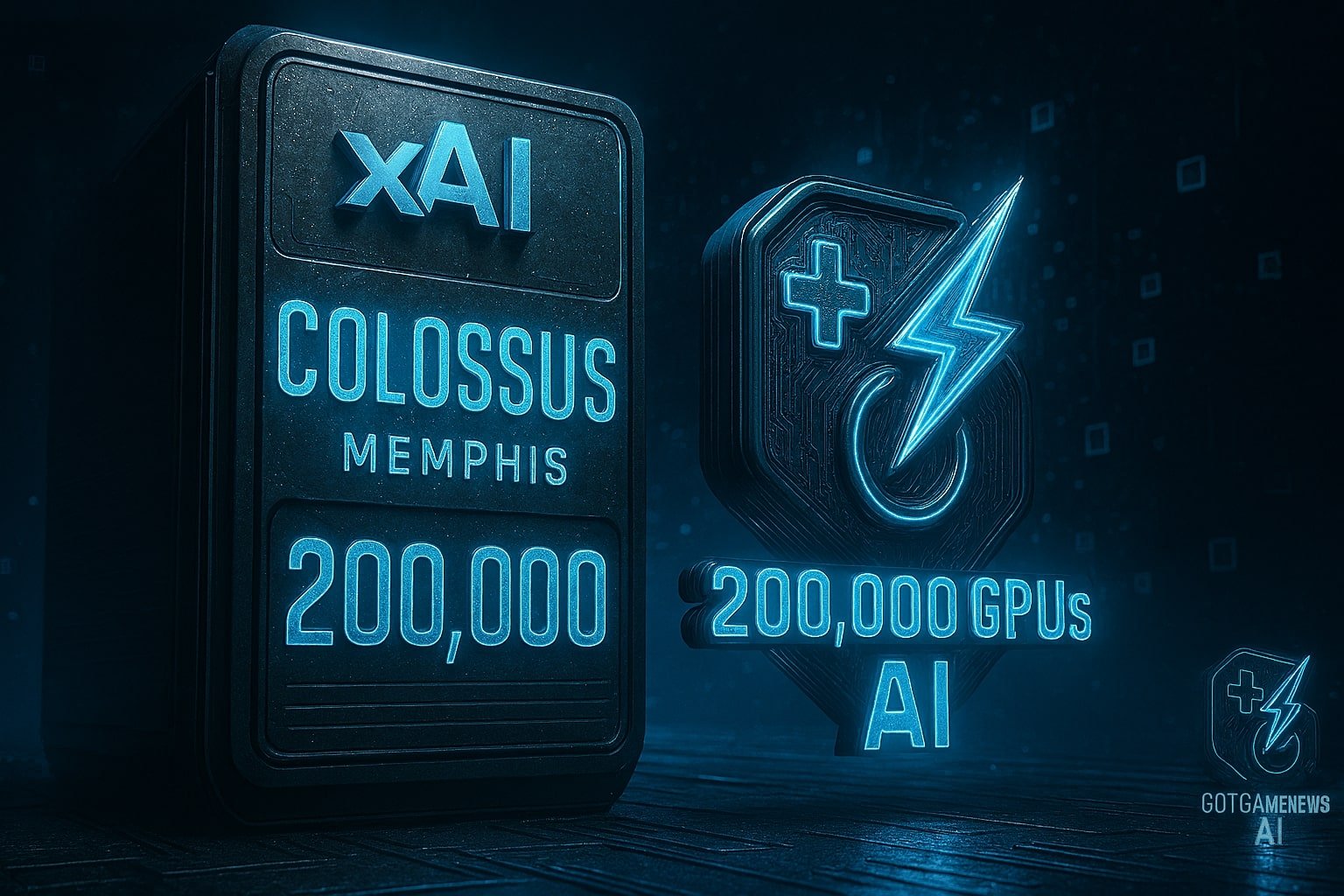The AI arms race just hit a new milestone. xAI’s “Colossus” cluster in Memphis has taken the global lead in AI compute power, packing an estimated 200,000 Nvidia H100-equivalent chips. That’s twice the size of any known competitor — and a massive signal of where AI infrastructure is heading.
- 1. xAI Colossus: The New World Champion
- 2. Cost and Energy: A Double-Edged Sword
- 3. The Top Compute Competitors
- 4. Why This Arms Race Matters
- 5. The Road Ahead: What’s Next?
- 6. The Compute Challenge: Can It Scale?
- 7. Critical Tensions: What’s at Stake?
- 8. Conclusion: Beyond Power, Toward Power with Purpose
1. xAI Colossus: The New World Champion
What’s the scale?
- 200,000 Nvidia H100-equivalent GPUs — twice as many chips as the next-largest cluster (Visual Capitalist, voronoiapp.com).
- Peak compute performance around 20.6 exaFLOPS (non‑sparse), which translates to over 400 quintillionfloating‑point operations per second (voronoiapp.com).
- Enough compute to re‑run GPT‑3’s full training cycle in less than two hours (voronoiapp.com, Visual Capitalist).
Construction speed
Remarkably, xAI built the initial 100K‑GPU Phase 1 cluster in just 122 days — a timeline Jensen Huang described as “superhuman” (macperformanceguide.com). They then doubled the size to 200K in just 92 additional days (macperformanceguide.com). For comparison, supercomputing installations of this scale typically take years, making xAI’s accomplishment a new benchmark in infrastructure speed (Wikipedia).
What’s powering it?
A plug-and-play approach in Memphis:
- Repurposed a 785,000‑sqft former Electrolux plant (Wikipedia).
- Initially powered via methane gas turbines due to insufficient local grid capacity (Tom’s Hardware).
- Eventually plans include a new 150 MW substation, a wastewater recycling facility, and on‑site battery storage (Tesla Megapacks) (Business Insider).
2. Cost and Energy: A Double-Edged Sword
Budget — rising fast
- Since 2019, hardware acquisition costs for top AI systems have been growing at a rate of 1.9× per year — doubling approximately every 13 months (Epoch AI).
- xAI’s Colossus hardware alone is estimated at $7 billion (arXiv).
- This trajectory means that by 2030, the first exascale systems could cost $200 billion and consume power equivalent to nine nuclear reactors (9 GW) (arXiv).
Power appetite — growing exponentially
- Peak 300 MW power demand — equivalent to supplying around 250,000 homes.
- From 2019 to 2025, peak power needs have also doubled every year (≈1.9× annual growth).
- Even with efficiency improvements (≈1.34× more FLOPS per watt annually), the total energy footprint is becoming hard to ignore.
3. The Top Compute Competitors
| Rank | Cluster/Owner | H100 Equivalents | Nationality | Certainty |
|---|---|---|---|---|
| 1 | xAI Colossus Phase 2 | 200K | U.S. | Likely |
| 2–3 | Meta AI 100K & Microsoft/OpenAI “Goodyear” | ~100K each | U.S. | Likely |
| 4 | xAI Colossus Phase 1 | 100K | U.S. | Confirmed |
| 5 | Oracle OCI Supercluster (H200) | 65,536 | U.S. | Likely |
| 6 | Tesla Cortex Phase 1 | 50,000 | U.S. | Confirmed |
| 7 | Lawrence Livermore El Capitan Phase 2 | 44,143 | U.S. DoE | Confirmed |
| 8 | CoreWeave H200s | 42,000 | U.S. | Likely |
| 9 | Lambda Labs H100/H200 | 32,000 | U.S. | Likely |
| 10 | Unnamed Chinese system | 30,000 | China | Confirmed |
Key observations:
- Every top cluster is located in the United States, except a single 30K‑chip Chinese system, reflecting how national policy, capital, and energy access are shaping the battlefield (voronoiapp.com, macperformanceguide.com, IT Pro, CSIS, Epoch AI).
- Notably absent are Google and Amazon, likely because they rely on custom AI silicon (e.g., TPUs, Trainium) that aren’t directly comparable in H‑series GPU counts.
4. Why This Arms Race Matters
A. Speed = Strategic Edge
Bringing GPT‑3-level training dramatically down from two weeks to under two hours empowers rapid iteration, shrinking development cycles from months to days. This enables:
- Faster experimentation and refinement.
- Agile deployment of updates or new models.
- Dynamic adjustments to adversarial or safety concerns.
Effectively, whoever controls the fastest training pipeline holds a tactical advantage.
B. Industry Consolidation & Barriers to Entry
With costs ballooning into the billions, AI compute is becoming an oligopoly:
- Only well-resourced tech giants (Meta, Microsoft, xAI) and occasionally governments can afford the buildout.
- Startups and academia are increasingly unable to fund frontier compute — exacerbating knowledge concentration and reducing diversity in innovation.
- Meta CEO Mark Zuckerberg has pledged hundreds of billions in compute expansion and aims for million‑GPU clusters by 2027. Total datacenter capex from top tech players is projected at $1.7 trillion by 2035.
C. Environmental & Ethical Fallout
- Local pollution: Memphis residents have reported xAI running 35 methane gas turbines without proper permits — emitting nitrogen oxides tied to respiratory illness.
- Regulatory loopholes: By calling turbines ‘temporary’, xAI sidestepped Clean Air Act permitting; a public hearing on pollution is underway (Tom’s Hardware).
- Energy demand: At 300 MW, xAI’s site could equal multiple nuclear plants. Reducing carbon emissions in this context is a tall order (arXiv, Epoch AI, NVIDIA Newsroom).
- Water usage: Plans call for 5–10 million gallons/day of recycled wastewater — critical in areas with water concerns like arsenic in groundwater (Wikipedia, Tennessee Lookout).
D. National Security & Global Tech Power
- The U.S. currently controls ~75% of global AI supercomputing performance; China ~15%.
- Future governance of AI compute — including energy policy, export controls, and international collaboration — could shape the dominance of U.S. tech in AI.
5. The Road Ahead: What’s Next?
xAI’s Ambitions
- Expand to 1 million GPUs — the Memphis Chamber confirmed intent and planning permissions.
- Continue rolling out local infrastructure: 150 MW substation, battery storage, wastewater recycling.
- Integrate AI across Elon Musk’s ecosystem — X (Twitter), SpaceX, etc., powered by Colossus/Grok.
Meta’s Mega‑Scale Plans
- Building 1 GW+ datacenters (Prometheus, Hyperion) across Ohio and Louisiana (IT Pro), dwarfing existing 150 MW sites.
- Pledged hundreds of billions more in compute, targeting million‑GPU clusters by 2027.
- Aggressive recruitment; reportedly offering top talent $200 million contracts.
Other Players
- Microsoft/OpenAI continues building “Goodyear” (~100K H100s) cluster.
- Oracle, Tesla, CoreWeave, Lambda each operate at tens of thousands of GPUs.
- Lawrence Livermore’s El Capitan remains the most powerful public-sector system — ~44K GPUs.
- Implicit players — Google (TPU), Amazon (Trainium) — lag in public H-series counts, but could be operating large custom clusters.
6. The Compute Challenge: Can It Scale?
Infrastructure is the bottleneck
- Building an on‑site substation + grid upgrades takes years, but AI labs need super‑fast timelines.
- xAI’s mobilization of portables + emergency gas turbines is indicative of a broader “any means necessary” approach.
- Future scaling — to million‑GPU or exascale systems — will demand GW-scale power, robust cooling, and resilient networks.
Policy and regulation are catching up slowly
- Environmental groups are now targeting air permits, citing pollution and community health (Politico).
- Cities without industrial infrastructure like Memphis may struggle to attract or support future megaclusters — leaving the field to a few U.S. regions.
- The IFP (Infrastructure for the Future Program) stresses the need for policy frameworks to accelerate AI‑scale datacenter buildouts while ensuring energy reliability and security.
7. Critical Tensions: What’s at Stake?
Compute monopoly vs democratization
- As compute becomes the limiting resource, power — both political and commercial — is tied to who controls datacenters.
- This risks locking in a few players as gatekeepers of AI’s next frontier — with consequences for diversity, accessibility, and public benefit.
Environmental justice vs technical ambition
- Siting megaclusters in lower-income or minority communities often coincides with regulatory lapses (e.g., oversized turbine use) and legacy pollution concerns.
- Garnering permits is easier when infrastructure is deployed as “temporary,” but community pushback is mounting.
National leadership vs global risk
- U.S. dominance in AI compute may bring strategic advantages, but also responsibilities — energy, regulation, and equitable access.
- China and the EU are ramping up their efforts — with implications for global AI governance, competition, and potentially an international “compute covenant.”
8. Conclusion: Beyond Power, Toward Power with Purpose
The global race for AI compute isn’t just about clustering more GPUs; it’s about who gets to dictate the future of intelligence. Today’s leaderboard, led by xAI’s Colossus, outlines the landscape — but the cracks are already showing:
- Inflation in cost and energy is confining frontier AI to a handful of nations and firms.
- Local impact — taxing grids, eroding environmental quality, and exposing economic inequalities.
- National policy — struggling to adapt before the trillion-dollar clusters arrive.
Looking ahead:
- Will environmental regulations respond before lines are drawn on the power grid?
- Can energy infrastructure — renewable or nuclear — scale fast enough to keep pace?
- Will compute democratize — and who wins if it doesn’t?
AI’s next phase depends as much on kilowatt-hours and permit hearings as it does on FLOPS. And in this crucible, the question isn’t just how big your cluster is — it’s what you build with it, in whose name, and under whose oversight.






